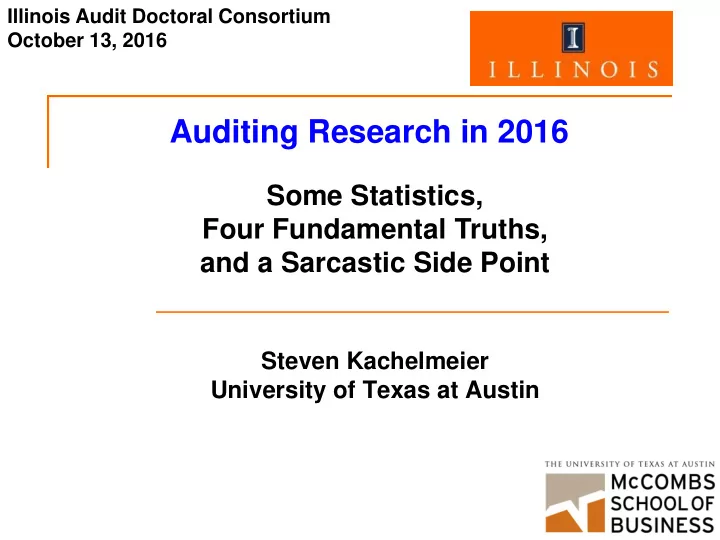

Illinois Audit Doctoral Consortium October 13, 2016 Auditing Research in 2016 Some Statistics, Four Fundamental Truths, and a Sarcastic Side Point Steven Kachelmeier University of Texas at Austin
Some Statistics
Auditing articles in TAR and JAR 30 25 20 15 10 5 0 1985 1990 1995 2000 2005 2010 2015
Total articles in TAR and JAR 120 100 80 60 40 20 0 1985 1990 1995 2000 2005 2010 2015 Auditing Total
Auditing articles as a percentage of total articles 40% 35% 30% 25% TAR Total 20% 15% JAR 10% 5% 0% 1985 1990 1995 2000 2005 2010 2015
Auditing acceptances vs. submissions Data from The Accounting Review , 2008-2015: Acceptances Submissions 50% 50% 40% 40% 30% 30% 20% 20% 10% 10% 0% 0% Auditing Financial Auditing Financial Reporting Reporting Source: TAR Annual Report and Commentary, Nov. 2015
Some statistics -- Takeaways Auditing remains a viable part of the overall accounting research portfolio. The prognosis is better than it was 15 years ago. Dare to be different. If you’re good at auditing, do it.
Note that I didn’t write “Follow your passion”
Another reason I like auditing Integrating research with teaching Hales ( JAR , 2007) Lennox and Pittman ( TAR , 2011) Lisowsky, Minnis, and Sutherland (working paper, 2016) Bennett and Hatfield ( TAR , 2013) Daugherty and Neely ( Issues in Accounting Educ. , 2011) Reffett ( TAR , 2010) Backof ( TAR , 2015) Czerney (working paper, 2015) Kachelmeier and Messier ( TAR , 1990) Messier, Kachelmeier, and Jensen ( AJPT , 2001) Brody, Lowe, and Pany ( Accounting Horizons , 2003) Gul and Goodwin ( TAR , 2009) Earley ( Business Horizons , 2015) Bowlin ( TAR , 2011) Kachelmeier and Van Landuyt (working paper, 2016) Kachelmeier, Majors, and Williamson ( TAR , 2014) Elder and Allen ( TAR , 2003) Kachelmeier, Schmidt, and Valentine (working paper, 2016)
Four Fundamental Truths
Fundamental Truth 1 The F word is far more prevalent in auditing than it used to be. No, not that F word. FRAUD
How far we have come Consider “Strategic Considerations in Auditing,” an analytic model by Fellingham and Newman in the October 1985 issue of The Accounting Review . Both the manager and the auditor want the financial statements to be correct. However, strategic tension arises because the manager wants the auditor to do the work and the auditor wants the manager to do the work. We have come a long way since then.
Fundamental Truth 2 Given Fundamental Truth #1, there is no stable equilibrium in which the manager reports honestly and the auditor audits diligently. If the manager reports honestly, the auditor will save money by auditing less thoroughly. But if the auditor is less thorough, the manager will “test the waters” with distorted reporting. See, for example, the mixed-strategy experiments by Bowlin, Hales, and Kachelmeier ( RAST , 2009) and Bowlin, Hobson, and Piercey ( TAR , 2015) .
Fundamental Truth 3 Risk-based auditing is inherently unstable. If the auditor is less thorough in a low-risk area, that area does not stay low risk. Classic example: HealthSouth For an experimental test of this reasoning, see Bowlin ( The Accounting Review , July 2011). Fortunately, humans are averse to even “low risks” of fraud – see Kachelmeier, Majors, and Williamson ( The Accounting Review , Nov. 2014).
The slide I use to illustrate this point in class: Two low-risk settings: Low risk of bad weather Low risk of finding a weapon In which setting are you more comfortable lowering your protections against risk?
Fundamental Truth 4 Audits should never fail because of impaired independence. But they do. Proof: Conceptually, audits can only fail if 1. The auditor doesn’t do enough work (failure of effort), or 2. The auditor does enough work but bows to client pressure (failure of independence).
Fundamental Truth 4 Audits should never fail because of impaired independence. But they do. Paradox: Why expend the cost of diligent effort to find out that the client is incorrect and then agree with the client anyway? Documenting but disregarding evidence can even make auditors worse off than remaining ignorant (Reffett, TAR , Nov. 2010; Backof, TAR , Nov. 2015).
Sarcastic Side Point
The hottest topic in auditing today With respect to auditing, the term “data analytics” is mostly a fancy, high-tech way to say “analytical review.” Mantra of the day: “Data analytics removes the need to sample. We can now test 100%!” My reaction:
What the firms are really telling us The hope is that data analytics will enable auditors to understand the business better, identify problem areas, and avoid the high costs of more traditional audit testing. We’ve been down this road before:
Some of this is very good! Example: Mining the general ledger for anomalies. Still, I submit that some direct observation and external corroboration / confirmation will remain an integral part of any effective audit. Comparing internal databases to internal databases can only go so far. Clever fraudsters can make anything look reasonable.
Corollary to Sarcastic Side Point Visualization is a fancy way to say “pictures and graphs.” Traditional Visualization: communication: After this session, we have a reception.
Visualization The fact that pictures can be more effective than words (or numbers) is nothing new. From “Communicating Financial Information Through Multidimensional Graphics,” by Shane Moriarity, J. of Acctg. Research , Spring 1979:
Recommend
More recommend